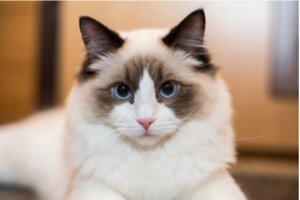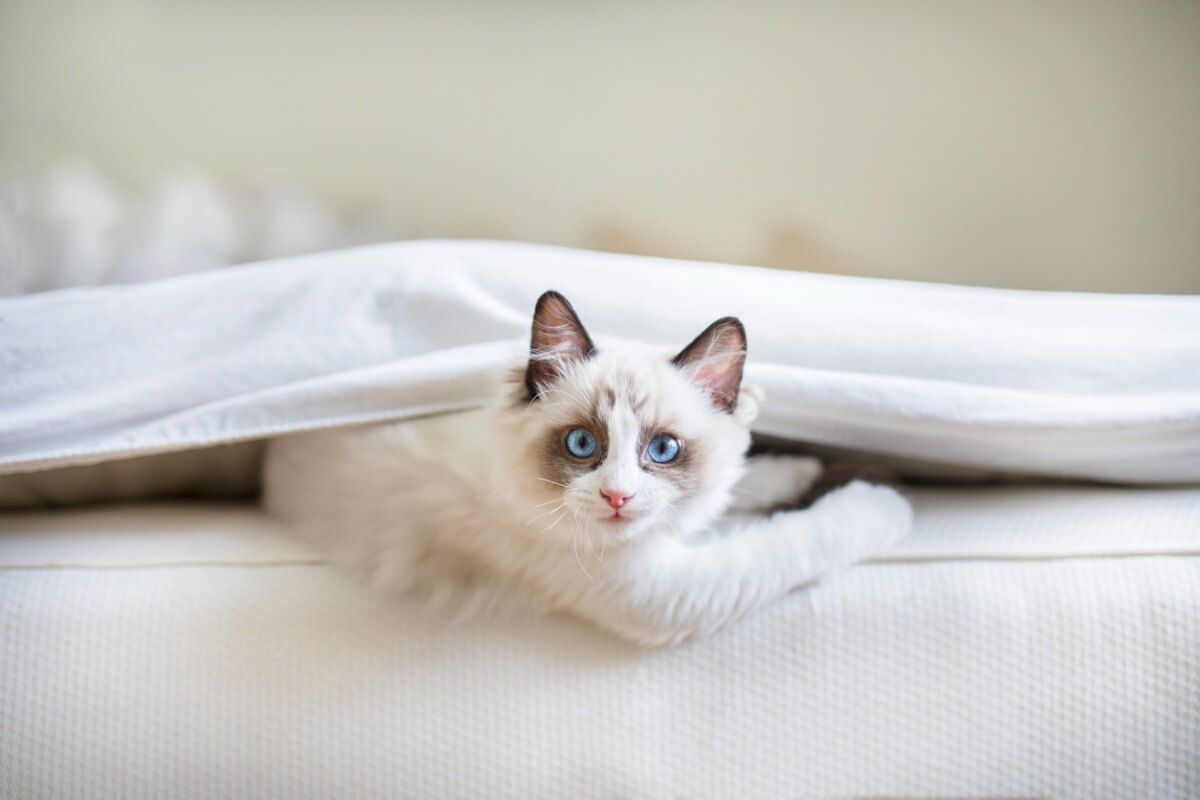Common Diseases in the Ragdoll Cat


Written and verified by the biologist Samuel Sanchez
Purebred felines are more prone to certain inherited conditions. This is due to artificial selection carried out by humans, as their genome has been altered over generations through successive crossbreeding to favor the appearance of certain traits over others. Here we’ll show you the most common diseases in the ragdoll cat, a feline as beautiful as it is delicate.
Although this breed of cat is quite robust, and enjoys adequate general health, there are certain typical conditions that are often due to genetic and environmental issues. Here we’ll tell you all about them so that you can detect them in your pets before it’s too late.
The most common diseases in the ragdoll cat
The ragdoll cat originated in the United States (California) in the sixties. Since then, it has become one of the most popular cat breeds because of its beautiful appearance, unusual calmness, and friendly character. In fact, their name came about because of how little it bothers these cats to be held and cuddled.
In addition to their good nature, ragdoll cats are known to tolerate pain well and mask it. This doesn’t mean that they don’t suffer, but it can be difficult to detect illness and disease in its early stages in this breed of feline. Because of this, we recommend that you read all about the following typical diseases of the ragdoll cat, and learn to detect early signs of discomfort in your pet.

1. Periodontitis
This condition isn’t unique to the breed that concerns us, but affects almost all felines (regardless of their genetics and condition). Dental problems are extremely common in cats over the age of 3, as up to 85% of them show some type of oral lesion due to lack of care as they age.
When tartar accumulates on their teeth, gingivitis develops, which will evolve into periodontitis if not treated. This condition corresponds to an infection of the gums, which manifests itself with oral bleeding, redness, a lack of appetite, and even tooth loss. It’s necessary to treat this condition with antibiotics and possible surgery.
2. Cardiomyopathies
As indicated by professional sources, cardiomyopathies are the conditions that affect the heart muscle in one way or another. The most common variant of all within this group is hypertrophic cardiomyopathy, which consists of a thickening of the heart tissue due to physiological imbalances (especially hormonal).
There’s a certain genetic predisposition to suffer from this condition and the ragdoll is one of the most affected in this regard. In addition, the symptoms it causes are usually quite mild at first, and difficult to detect (rapid breathing, lethargy, and lack of appetite). Certain genetic tests can be carried out to diagnose this disease at any time in the life of the cat.
Up to 20% of ragdolls suffer from hypertrophic cardiomyopathy. Without a doubt, it’s one of the most serious conditions in the breed.
3. Arterial thromboembolism
Thromboembolism, also known as arterial embolism, occurs when a clot (thrombus) forms in a blood vessel and travels to a thinner artery to become embedded in it and prevent blood flow. In cats, thrombi most commonly lodge in the hind limbs, causing lameness, paralysis and coldness to the touch.
The ragdoll is prone to this condition. The British Shorthair, Maine Coon and other breeds also show predisposition.
4. Polycystic kidney disease
Polycystic kidney disease, known as PKD, is a genetic, progressive, irreversible condition that causes lethal damage to the cat’s kidneys. It’s due to mutations in the genes involved in kidney maintenance (PKHD1, PKHD2 and others) and some breeds are more prone to it than others. Undoubtedly, the Persian is the most affected.
Professional sources estimate that up to 10% of ragdolls have signs of chronic kidney disease, although only 3% of them manifest PKD. The most common symptoms of this condition are a loss of appetite, weight loss, nausea, vomiting, and excessive thirst. The only possible treatment is supportive care, as there’s no solution to this condition.
This isn’t one of the most common diseases in ragdoll cats, but it is one of the most important.
5. Mast cell tumors
Mast cell tumors represent a rather aggressive type of skin cancer. They’re masses of mast cells (cell bodies distributed throughout the body and involved in allergic reactions) that have collectively become cancerous. The lumps have a firm, pinkish appearance and no hair around them.
On the other hand, there are also internal tumor forms that originate in the spleen and tend to spread to the liver, intestine, lymph nodes, and lungs. In these cases, the symptoms will vary depending on which area is most affected.
The initial treatment is surgical removal of the tumors whenever possible. If there are signs of metastasis, chemotherapy and radiotherapy may also be used. The prognosis varies greatly in each case and depends on the amount of tumors present in the feline’s body.
Most skin lumps in cats are benign in nature. However, it never hurts to be cautious and go to the vet as soon as one is detected.

Prevention is the best option
As you can see, there are several common cat diseases in ragdoll cats. Some of them are typical of the breed, while others are highly prevalent in all domestic felines regardless of their gene pool. Be that as it may, we need to recognize that this animal has certain problems associated with its breeding (especially cardiomyopathy).
The best way to avoid any genetic diseases in purebred domestic cats is to have the cats DNA tested prior to breeding. Many of these conditions are detectable before symptoms occur and it’s the duty of owners not to breed felines with deleterious mutations. This is the only way to ensure that the offspring are both healthy and beautiful.
All cited sources were thoroughly reviewed by our team to ensure their quality, reliability, currency, and validity. The bibliography of this article was considered reliable and of academic or scientific accuracy.
- Ragdoll, Animal Health Clinic. Recogido a 22 de noviembre en https://ahcfargo.com/client-resources/breed-info/ragdoll/
- Prueba de la cardiomiopatía hipertrófica para el ragdoll, GENIMAL Biotechnologies. Recogido a 22 de noviembre en https://ahcfargo.com/client-resources/breed-info/ragdoll/
This text is provided for informational purposes only and does not replace consultation with a professional. If in doubt, consult your specialist.